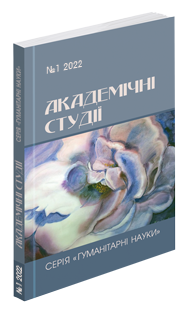Abstract
The article considers the analogy as a technique and principle of modeling the art world in the famous works of the Ukrainian Middle Ages – "Tales and passions, and praise to the holy martyrs Boris and Gleb." The relevance of the study is that so far in domestic medieval studies little attention has been paid to the peculiarities of modeling the art world in medieval literary monuments, so the aim of the article is to analyze one of the common means of such modeling – analogy (for example, "Legends"). The unknown author of "Legends", talking about the suffering and death of the Blessed, the first Russian saints Boris and Gleb, resorted to the artistic technique of analogy, the main principle of which is the comparison by similarity or association of objects, concepts, phenomena. They are compared by meaning, purpose, formal features, function and purpose of artistic expression. The motive for fratricide is revealed on the basis of two types of analogy, which differ according to the sources of origin, namely the historical (chronicle) analogy and the biblical analogy. The historical analogy is formed by a medieval author on the basis of a synthesis of artistic means of comparison and allegorical images, which are inherently allusive. The text "Legends" also outlines the biblical figurative analogy, which can be traced in the comparison of the image of Sviatopolk with the biblical image of Cain. The type of similar thinking of the medieval author changes dramatically in the modeling of the artistic image of Blessed Prince Gleb. This analogy is formed on the basis of symbolization of reality. In "Legend" the medieval author models the artistic text and image system on the basis of artistic reception of analogy. The technique used has different genesis in the text: historical (chronicle), biblical, mythological. Means of modeling analogy are also traced, among which comparisons, metaphors, allusions, and allegories stand out. The metaphorical language of the studied monument is generated in the text of the XII century. such types of personification as phytomorphisms and zoomorphisms. the "Legend" as a whole is dominated by figurative analogy, which emphasizes the story and gives new semantic nuances to the artistic universe of the literary work.
References
Бакаєва М. Персоніфікація як підвид метафори: історико-таксономічний підхід. URL: https: //er.nau.edu.ua/bitstream/ NAU/ 10700/1/ 202008. pdf.
Біблія, або Книга Святого Письма Старого й Нового Завіту / пер. Івана Огієнка. Київ : Українське біблійне товариство, 2005.
Словник тропів і стилістичних фігур / автор-укладач В. Ф. Святовець. Київ : Академія, 2011.
Повість временних літ. URL: http://litopys.org.ua/pvlyar/yar.htm
Сказаніє і страсть, і похвала святим мученикам Борису та Глібу. URL: http://litopys.org.ua/oldukr/ borhlib.htm
Туптало Д. Житія Святих (Четьї Мінеї). Том. IV / з давньоукр. перекл. Д. Сироїд. Львів : Свічадо, 2007.
Фрай Н. Великий код: Біблія і література / з англ. перекл. Ірина Старовойт. Львів : Літопис, 2010.
Шумило С. В. Уявлення про Київ як «другий Єрусалим» в церковно-суспільній думці Русі-України : зб. матеріалів всеукраїнської наукової конференції. Київ, 2013. С. 196–227.

